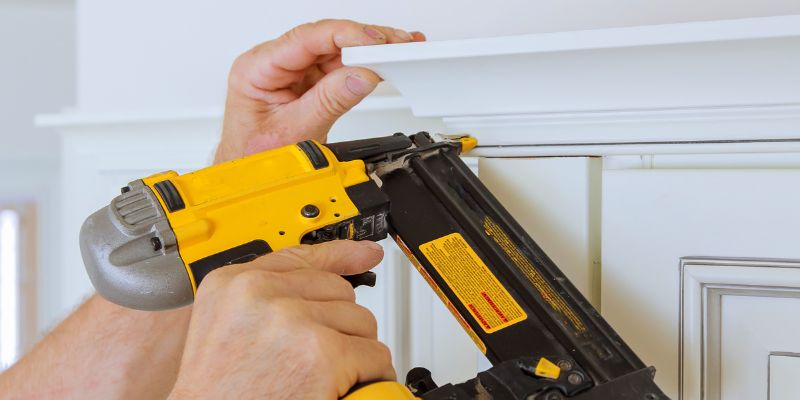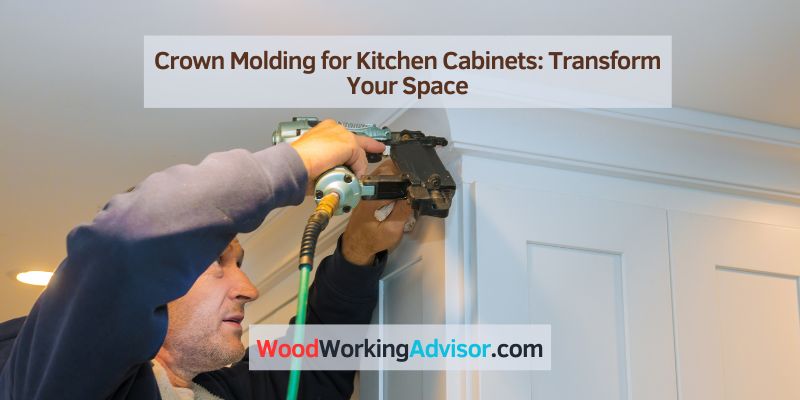Crown molding for kitchen cabinets adds a decorative touch and finished look to the upper edge of the cabinets. It enhances the visual appeal of the entire kitchen space and adds a touch of elegance and sophistication.
Adding crown molding to kitchen cabinets is a popular way to upgrade the look of the kitchen. With various styles and materials available, you can choose a molding that complements your kitchen’s design. Whether you prefer a contemporary, traditional, or transitional style, there’s a crown molding option to suit your taste.
Installing crown molding is a relatively simple DIY project, but it can also be done professionally for a flawless finish. In this guide, we’ll discuss the benefits, different design options, and installation process of crown molding for kitchen cabinets.
Historical Charm To Modern Elegance
When it comes to transforming kitchen cabinets from historical charm to modern elegance, there’s no denying the impact of crown molding. This traditional architectural feature has stood the test of time, evolving to complement contemporary kitchen designs. The addition of crown molding not only brings a touch of refinement but also serves as a vital element in seamlessly blending the old with the new.

The Evolution Of Crown Molding In Interior Design
Originating in ancient Greece and Rome, the use of crown molding has a rich historical significance. It was initially crafted from stone and used to adorn the tops of columns and buildings, symbolizing grandeur and elegance. As architecture advanced, wooden crown molding emerged, becoming a quintessential element of interior design during the Renaissance period. Over time, this decorative feature has evolved in style and application, from intricately carved designs in traditional homes to sleek, minimalist profiles in modern spaces.
Role Of Crown Molding When Merging Traditional And Contemporary Kitchens
In today’s interior design landscape, the role of crown molding extends beyond historical aesthetics. When merging traditional and contemporary kitchens, crown molding serves as a unifying element, bridging the gap between old-world charm and modern sophistication. It adds depth and character to kitchen cabinets, creating a seamless transition between the two design styles. Whether it’s enhancing the elegance of classic cabinetry or providing a touch of sophistication to sleek, minimalist kitchen units, crown molding plays a pivotal role in harmonizing contrasting design elements.
Choosing The Right Crown Molding
When it comes to upgrading the look of your kitchen cabinets, choosing the right crown molding can make a significant impact. Crown molding adds a touch of elegance and sophistication to the overall kitchen design, enhancing the visual appeal of the cabinetry. However, selecting the perfect crown molding involves various considerations, including the material, style, size, customization options, and the impact of ceiling height. In this guide, we will delve into the essential factors to consider when choosing crown molding for kitchen cabinets.
Factors To Consider: Material, Style And Size
Material, style, and size are crucial factors that determine the overall aesthetic of the crown molding. The material choice can range from , each offering distinct characteristics in terms of durability and visual appeal. Similarly, the style of the crown molding, whether traditional or modern, should harmonize with the existing kitchen decor. Additionally, considering the size of the molding is essential to ensure it complements the proportions of the kitchen cabinets without overpowering or underwhelming the space.
Customization Vs. Ready-made Options
When exploring crown molding options, homeowners can opt for customized or ready-made solutions. Customized options offer the flexibility to match the specific design requirements of the kitchen, ensuring a cohesive and personalized look. On the other hand, ready-made options provide convenience and a range of pre-designed styles that cater to various preferences and budgets.
Impact Of Ceiling Height On Crown Molding Selection
The ceiling height plays a significant role in the selection of crown molding. Taller ceilings can accommodate larger and more elaborate crown molding styles, enhancing the grandeur of the space. Conversely, lower ceilings may require more streamlined and minimalist molding designs to avoid overwhelming the visual appeal of the kitchen cabinets.
Installation Insights
Gain valuable insights into the installation of crown molding for kitchen cabinets. Explore expert tips and techniques for a seamless and professional finish. Discover the essential steps and tricks to enhance the aesthetics and functionality of your kitchen space with crown molding.
Professional Installation Vs. Diy Approach
When it comes to installing crown molding on kitchen cabinets, homeowners often weigh the option of hiring a professional or taking the DIY approach. While hiring a professional ensures expertise and a precise finish, it may involve higher costs. On the other hand, the DIY approach can be cost-effective, but it requires careful attention to detail and the right tools to achieve a professional-looking result. Homeowners should carefully consider their skill level and the complexity of the installation before making a decision. It is important to remember that improper installation can result in a subpar aesthetic and may even compromise the integrity of the kitchen cabinets.
Key Steps Involved In The Installation Process
Whether opting for professional installation or the DIY approach, the key steps involved in installing crown molding on kitchen cabinets remain the same. The process typically includes measuring and marking the cabinets, cutting the molding to size, and securing it in place using appropriate tools and techniques. Prior to installation, it is crucial to carefully plan and measure to ensure a seamless and accurate fit. Additionally, proper sealing and painting may be necessary to achieve a polished look.
Common Pitfalls And How To Avoid Them
During the installation of crown molding for kitchen cabinets, several common pitfalls can arise. These include inaccurate measurements, uneven cuts, improper sealing, and inadequate support. To avoid these issues, homeowners should meticulously measure and plan their installation, invest in quality tools, and seek guidance from sources such as tutorials or professionals. Taking the time to properly prepare and execute the installation process can help prevent potential pitfalls and ensure a flawless result.

Maintenance And Longevity
Crown molding is a beautiful and functional addition to kitchen cabinets, adding elegance and sophistication to the overall design. When it comes to maintaining and ensuring the longevity of crown molding, proper care and attention are essential. This article will discuss best practices for cleaning and upkeep, tips for repairing and refurbishing crown molding, and when to replace or refinish existing crown molding.
Best Practices For Cleaning And Upkeep
Regular cleaning and maintenance are crucial for preserving the beauty and integrity of crown molding. Here are some best practices:
- Dust regularly: Use a soft, damp cloth or a microfiber duster to remove dust and debris from the surface of the crown molding.
- Avoid harsh chemicals: When cleaning, opt for mild soap and water to prevent damage to the finish of the molding.
- Inspect for damage: Periodically check for any signs of wear, chipping, or peeling, and address any issues promptly to prevent further damage.
- Protect from moisture: Ensure that the kitchen environment is well-ventilated to prevent moisture build-up, which can lead to mold and mildew on the crown molding.
Tips For Repairing And Refurbishing Crown Molding
Over time, crown molding may require repairs or refurbishment to maintain its appearance and structural integrity. Here are some tips:
- Fill in gaps: Use wood filler to fill any gaps or cracks in the molding, ensuring a smooth and seamless appearance.
- Sand and repaint: If the paint or finish is worn out, carefully sand the surface and apply a fresh coat of paint or stain to rejuvenate the crown molding.
- Replace damaged sections: In the case of severe damage, it may be necessary to replace damaged sections of the molding to maintain its overall look and functionality.
When To Replace Or Refinish Existing Crown Molding
Despite proper maintenance, there may come a time when replacement or refinishing is necessary for the crown molding. Consider the following factors:
| Replacement | Refinishing |
|---|---|
| If the molding is extensively damaged or warped beyond repair, replacement may be the best option. | If the finish is worn or outdated, refinishing can provide a cost-effective way to revitalize the appearance of the crown molding. |
| When remodeling the kitchen and seeking a new design or style, replacement may be preferred to align with the updated aesthetic. | Refinishing is suitable for minor cosmetic issues, such as scratches or fading, to restore the beauty of the molding. |
Transform Your Space With Crown Molding Details
When it comes to enhancing the visual appeal of your kitchen space, crown molding provides an elegant and timeless touch. Crown molding seamlessly integrates with kitchen cabinetry, adding a touch of sophistication and luxury to the overall design. The intricate details and refined craftsmanship of crown molding bring a sense of grandeur to the space, elevating the aesthetic allure of your kitchen cabinets.
Strategic lighting can emphasize the exquisite details of crown molding and further accentuate the charm it brings to your kitchen cabinets. Mounted lights or LED strips can be skillfully incorporated to illuminate the crown molding, creating a captivating visual impact. Proper lighting not only enhances the beauty of the crown molding but also adds depth and dimension to the entire kitchen space, evoking a sense of opulence and elegance.
The transformation that crown molding can bring to your kitchen is truly remarkable. Before the addition of crown molding, your kitchen cabinets may appear ordinary and lackluster. However, once crown molding is expertly installed, the visual impact is undeniable. The space is instantly elevated, exuding a more polished and refined ambiance. Crown molding has the power to elevate the overall aesthetics, making your kitchen space feel more luxurious and inviting.
Frequently Asked Questions For Crown Molding For Kitchen Cabinets
What Are The Benefits Of Adding Crown Molding To Kitchen Cabinets?
Adding crown molding to kitchen cabinets enhances the overall aesthetic, providing a touch of elegance and sophistication. It also helps to conceal any gaps between the cabinets and the ceiling, giving a seamless appearance.
How To Choose The Right Crown Molding For Kitchen Cabinets?
When selecting crown molding for kitchen cabinets, consider the style of the cabinets, ceiling height, and personal preference. Opt for a molding that complements the cabinet design and suits the overall kitchen decor.
Can Crown Molding Be Installed On Existing Kitchen Cabinets?
Yes, crown molding can be added to existing kitchen cabinets. It involves accurate measurements, proper cutting, and careful installation. With the right tools and techniques, it’s possible to achieve a professional-looking result on the existing cabinets.
What Tools Are Needed For Installing Crown Molding On Kitchen Cabinets?
The tools required for installing crown molding on kitchen cabinets include a miter saw, coping saw, tape measure, pencil, nail gun, and wood glue. These tools are essential for precise cutting, measuring, and secure attachment of the molding.
Conclusion
Crown molding is a simple yet effective way to enhance the aesthetics of your kitchen cabinets. Its ability to add a touch of elegance and charm can truly transform the look and feel of your kitchen space. With a wide variety of styles and finishes available, crown molding offers versatility to suit any design preference.
In addition to its aesthetic benefits, it also helps to conceal gaps and irregularities, providing a polished and cohesive appearance. Incorporating crown molding into your kitchen cabinets is a budget-friendly and impactful upgrade that will not only elevate the overall appeal of your kitchen but also increase the value of your home.



One thought on “Crown Molding for Kitchen Cabinets: Transform Your Space”